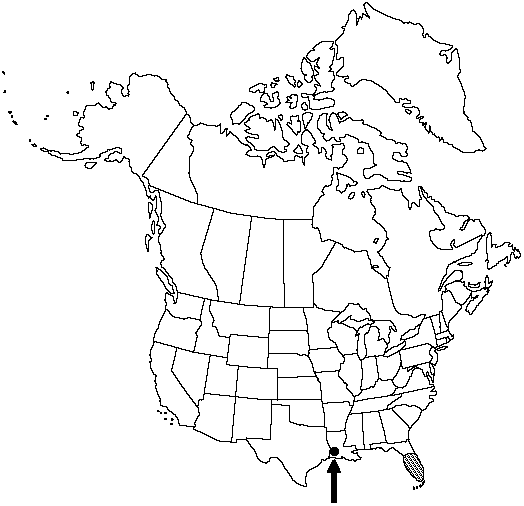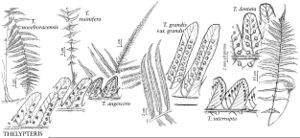Difference between revisions of "Thelypteris interrupta"
Jap. J. Bot. 38: 314. 1963.
FNA>Volume Importer |
imported>Volume Importer |
||
| (7 intermediate revisions by 2 users not shown) | |||
| Line 8: | Line 8: | ||
}} | }} | ||
|common_names=Hottentot fern;Willdenow's fern;spready tri-vein fern | |common_names=Hottentot fern;Willdenow's fern;spready tri-vein fern | ||
| − | |basionyms={{Treatment/ID/ | + | |special_status={{Treatment/ID/Special_status |
| + | |code=F | ||
| + | |label=Illustrated | ||
| + | }} | ||
| + | |basionyms={{Treatment/ID/Basionym | ||
|name=Pteris interrupta | |name=Pteris interrupta | ||
|authority=Willdenow | |authority=Willdenow | ||
| + | |rank=species | ||
| + | |publication_title=Phytographia, | ||
| + | |publication_place=13. 1794 | ||
}} | }} | ||
|synonyms={{Treatment/ID/Synonym | |synonyms={{Treatment/ID/Synonym | ||
|name=Cyclosorus gongylodes | |name=Cyclosorus gongylodes | ||
|authority=(Schkuhr) Link | |authority=(Schkuhr) Link | ||
| − | }}{{Treatment/ID/Synonym | + | |rank=species |
| + | }} {{Treatment/ID/Synonym | ||
|name=Cyclosorus interruptus | |name=Cyclosorus interruptus | ||
|authority=(Willdenow) H. Itô | |authority=(Willdenow) H. Itô | ||
| − | }}{{Treatment/ID/Synonym | + | |rank=species |
| + | }} {{Treatment/ID/Synonym | ||
|name=Cyclosorus tottus | |name=Cyclosorus tottus | ||
|authority=(Thunberg) Pichi-Sermolli | |authority=(Thunberg) Pichi-Sermolli | ||
| − | }}{{Treatment/ID/Synonym | + | |rank=species |
| + | }} {{Treatment/ID/Synonym | ||
|name=Dryopteris gongylodes | |name=Dryopteris gongylodes | ||
|authority=(Schkuhr) Kuntze | |authority=(Schkuhr) Kuntze | ||
| − | }}{{Treatment/ID/Synonym | + | |rank=species |
| + | }} {{Treatment/ID/Synonym | ||
|name=Thelypteris gongylodes | |name=Thelypteris gongylodes | ||
|authority=(Schkuhr) Small | |authority=(Schkuhr) Small | ||
| − | }}{{Treatment/ID/Synonym | + | |rank=species |
| + | }} {{Treatment/ID/Synonym | ||
|name=Thelypteris totta | |name=Thelypteris totta | ||
|authority=(Thunberg) Schelpe | |authority=(Thunberg) Schelpe | ||
| + | |rank=species | ||
}} | }} | ||
|hierarchy=Thelypteridaceae;Thelypteris;Thelypteris subg. Cyclosorus;Thelypteris interrupta | |hierarchy=Thelypteridaceae;Thelypteris;Thelypteris subg. Cyclosorus;Thelypteris interrupta | ||
| Line 38: | Line 51: | ||
}}<!-- | }}<!-- | ||
| − | --><span class="statement" id="st- | + | --><span class="statement" id="st-undefined" data-properties=""><b>Stems </b>long-creeping, cordlike, 3–6 mm diam. <b>Leaves</b> monomorphic, evergreen, 3–6 cm apart, 50–150(–250) cm. <b>Petiole</b> straw-colored to tan, 20–125 cm × 3–6 mm, scaleless. <b>Blade</b> 30–125 cm, broadest at base, gradually narrowed distally to pinnatifid apex. <b>Pinnae</b> 7–30 × 1–2 cm, incised 1/3–1/2(–3/5) of width; segments deltate, rounded to acute; proximal pair of veins from adjacent segments united at acute or obtuse angle below sinus, with excurrent vein 2–4 mm. <b>Indument</b> abaxially of hairs 0.1–0.3 mm on costae and veins, or hairs often lacking, costae also with tan, ovate scales; veins, costules, and costae adaxially glabrous or sparsely pubescent; blade tissue without hairs on both sides, or hairy abaxially, usually with red to orange, shiny, sessile, hemispheric glands abaxially. <b>Sori</b> round, medial to supramedial; indusia tan, glabrous to hairy; sporangia with red- or orange-capped, stalked, globose glands arising from sporangial stalks. <b>2n</b> = 144.</span><!-- |
-->{{Treatment/Body | -->{{Treatment/Body | ||
| Line 44: | Line 57: | ||
|elevation=0–50 m | |elevation=0–50 m | ||
|distribution=Fla.;La.;Mexico;West Indies in the Antilles;Central America;South America to Argentina;tropical and subtropical Asia;Africa. | |distribution=Fla.;La.;Mexico;West Indies in the Antilles;Central America;South America to Argentina;tropical and subtropical Asia;Africa. | ||
| − | |discussion=<p>D. B. Lellinger (1985) applied the name Thelypteris interrupta to specimens from India, while using T. totta (type from South Africa) for North American and South American specimens. Diploid cytotypes are known from Africa and Asia, whereas all counts from the Neotropics are tetraploid. Until more counts are available and the morphologic variation (chiefly in glands, pubescence, and leaf size) in this species complex is better understood, I prefer to circumscribe the species broadly.</p><!-- | + | |discussion=<p>D. B. Lellinger (1985) applied the name <i>Thelypteris interrupta</i> to specimens from India, while using T. totta (type from South Africa) for North American and South American specimens. Diploid cytotypes are known from Africa and Asia, whereas all counts from the Neotropics are tetraploid. Until more counts are available and the morphologic variation (chiefly in glands, pubescence, and leaf size) in this species complex is better understood, I prefer to circumscribe the species broadly.</p><!-- |
--><p>R. E. Holttum (1982) circumscribed Cyclosorus (as a genus) to include this species and one or two others.</p> | --><p>R. E. Holttum (1982) circumscribed Cyclosorus (as a genus) to include this species and one or two others.</p> | ||
|tables= | |tables= | ||
| Line 54: | Line 67: | ||
-->{{#Taxon: | -->{{#Taxon: | ||
name=Thelypteris interrupta | name=Thelypteris interrupta | ||
| − | |||
|authority=(Willdenow) K. Iwatsuki | |authority=(Willdenow) K. Iwatsuki | ||
|rank=species | |rank=species | ||
| Line 67: | Line 79: | ||
|publication title=Jap. J. Bot. | |publication title=Jap. J. Bot. | ||
|publication year=1963 | |publication year=1963 | ||
| − | |special status= | + | |special status=Illustrated |
| − | |source xml=https:// | + | |source xml=https://bitbucket.org/aafc-mbb/fna-data-curation/src/2e0870ddd59836b60bcf96646a41e87ea5a5943a/coarse_grained_fna_xml/V2/V2_815.xml |
|genus=Thelypteris | |genus=Thelypteris | ||
|subgenus=Thelypteris subg. Cyclosorus | |subgenus=Thelypteris subg. Cyclosorus | ||
|species=Thelypteris interrupta | |species=Thelypteris interrupta | ||
| − | |||
| − | |||
| − | |||
| − | |||
| − | |||
| − | |||
| − | |||
| − | |||
| − | |||
| − | |||
| − | |||
| − | |||
| − | |||
| − | |||
| − | |||
| − | |||
| − | |||
| − | |||
| − | |||
| − | |||
| − | |||
| − | |||
| − | |||
| − | |||
| − | |||
| − | |||
| − | |||
| − | |||
| − | |||
| − | |||
| − | |||
| − | |||
| − | |||
| − | |||
| − | |||
| − | |||
| − | |||
| − | |||
| − | |||
| − | |||
| − | |||
}}<!-- | }}<!-- | ||
-->[[Category:Treatment]][[Category:Thelypteris subg. Cyclosorus]] | -->[[Category:Treatment]][[Category:Thelypteris subg. Cyclosorus]] | ||
Latest revision as of 21:25, 5 November 2020
Stems long-creeping, cordlike, 3–6 mm diam. Leaves monomorphic, evergreen, 3–6 cm apart, 50–150(–250) cm. Petiole straw-colored to tan, 20–125 cm × 3–6 mm, scaleless. Blade 30–125 cm, broadest at base, gradually narrowed distally to pinnatifid apex. Pinnae 7–30 × 1–2 cm, incised 1/3–1/2(–3/5) of width; segments deltate, rounded to acute; proximal pair of veins from adjacent segments united at acute or obtuse angle below sinus, with excurrent vein 2–4 mm. Indument abaxially of hairs 0.1–0.3 mm on costae and veins, or hairs often lacking, costae also with tan, ovate scales; veins, costules, and costae adaxially glabrous or sparsely pubescent; blade tissue without hairs on both sides, or hairy abaxially, usually with red to orange, shiny, sessile, hemispheric glands abaxially. Sori round, medial to supramedial; indusia tan, glabrous to hairy; sporangia with red- or orange-capped, stalked, globose glands arising from sporangial stalks. 2n = 144.
Habitat: Wet roadside ditches, riverbanks, marshes, and cypress swamps
Elevation: 0–50 m
Distribution

Fla., La., Mexico, West Indies in the Antilles, Central America, South America to Argentina, tropical and subtropical Asia, Africa.
Discussion
D. B. Lellinger (1985) applied the name Thelypteris interrupta to specimens from India, while using T. totta (type from South Africa) for North American and South American specimens. Diploid cytotypes are known from Africa and Asia, whereas all counts from the Neotropics are tetraploid. Until more counts are available and the morphologic variation (chiefly in glands, pubescence, and leaf size) in this species complex is better understood, I prefer to circumscribe the species broadly.
R. E. Holttum (1982) circumscribed Cyclosorus (as a genus) to include this species and one or two others.
Selected References
None.
